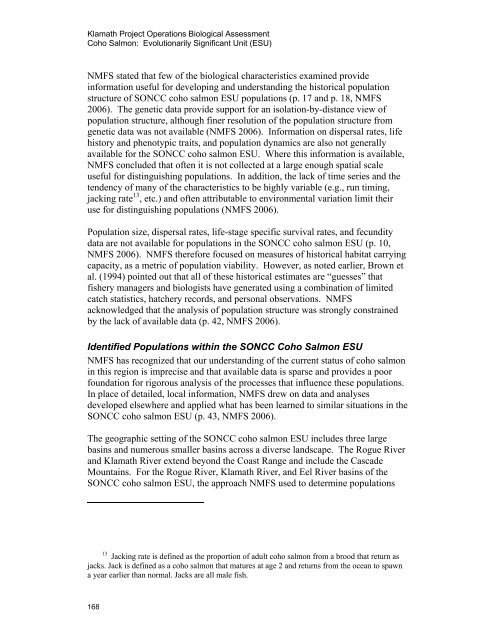Our new Biological Assessment is out - Klamath Basin Crisis
Our new Biological Assessment is out - Klamath Basin Crisis
Our new Biological Assessment is out - Klamath Basin Crisis
You also want an ePaper? Increase the reach of your titles
YUMPU automatically turns print PDFs into web optimized ePapers that Google loves.
<strong>Klamath</strong> Project Operations <strong>Biological</strong> <strong>Assessment</strong><br />
Coho Salmon: Evolutionarily Significant Unit (ESU)<br />
NMFS stated that few of the biological character<strong>is</strong>tics examined provide<br />
information useful for developing and understanding the h<strong>is</strong>torical population<br />
structure of SONCC coho salmon ESU populations (p. 17 and p. 18, NMFS<br />
2006). The genetic data provide support for an <strong>is</strong>olation-by-d<strong>is</strong>tance view of<br />
population structure, although finer resolution of the population structure from<br />
genetic data was not available (NMFS 2006). Information on d<strong>is</strong>persal rates, life<br />
h<strong>is</strong>tory and phenotypic traits, and population dynamics are also not generally<br />
available for the SONCC coho salmon ESU. Where th<strong>is</strong> information <strong>is</strong> available,<br />
NMFS concluded that often it <strong>is</strong> not collected at a large enough spatial scale<br />
useful for d<strong>is</strong>tingu<strong>is</strong>hing populations. In addition, the lack of time series and the<br />
tendency of many of the character<strong>is</strong>tics to be highly variable (e.g., run timing,<br />
jacking rate 13 , etc.) and often attributable to environmental variation limit their<br />
use for d<strong>is</strong>tingu<strong>is</strong>hing populations (NMFS 2006).<br />
Population size, d<strong>is</strong>persal rates, life-stage specific survival rates, and fecundity<br />
data are not available for populations in the SONCC coho salmon ESU (p. 10,<br />
NMFS 2006). NMFS therefore focused on measures of h<strong>is</strong>torical habitat carrying<br />
capacity, as a metric of population viability. However, as noted earlier, Brown et<br />
al. (1994) pointed <strong>out</strong> that all of these h<strong>is</strong>torical estimates are “guesses” that<br />
f<strong>is</strong>hery managers and biolog<strong>is</strong>ts have generated using a combination of limited<br />
catch stat<strong>is</strong>tics, hatchery records, and personal observations. NMFS<br />
acknowledged that the analys<strong>is</strong> of population structure was strongly constrained<br />
by the lack of available data (p. 42, NMFS 2006).<br />
Identified Populations within the SONCC Coho Salmon ESU<br />
NMFS has recognized that our understanding of the current status of coho salmon<br />
in th<strong>is</strong> region <strong>is</strong> imprec<strong>is</strong>e and that available data <strong>is</strong> sparse and provides a poor<br />
foundation for rigorous analys<strong>is</strong> of the processes that influence these populations.<br />
In place of detailed, local information, NMFS drew on data and analyses<br />
developed elsewhere and applied what has been learned to similar situations in the<br />
SONCC coho salmon ESU (p. 43, NMFS 2006).<br />
The geographic setting of the SONCC coho salmon ESU includes three large<br />
basins and numerous smaller basins across a diverse landscape. The Rogue River<br />
and <strong>Klamath</strong> River extend beyond the Coast Range and include the Cascade<br />
Mountains. For the Rogue River, <strong>Klamath</strong> River, and Eel River basins of the<br />
SONCC coho salmon ESU, the approach NMFS used to determine populations<br />
13 Jacking rate <strong>is</strong> defined as the proportion of adult coho salmon from a brood that return as<br />
jacks. Jack <strong>is</strong> defined as a coho salmon that matures at age 2 and returns from the ocean to spawn<br />
a year earlier than normal. Jacks are all male f<strong>is</strong>h.<br />
168










